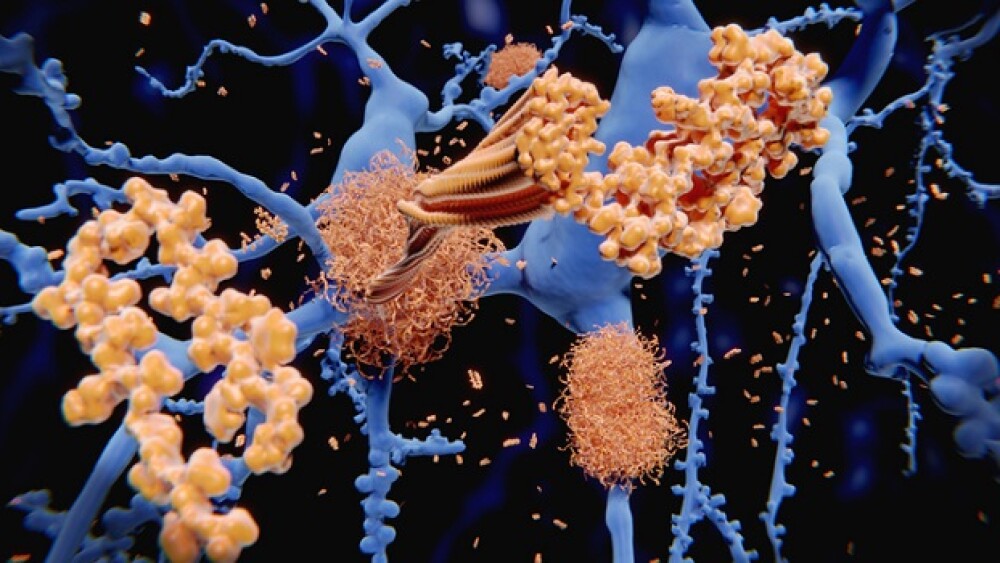Researchers elucidate the component structure of Alzheimer’s-associated plaques, shedding light on anti-amyloid antibodies’ mechanism of action.
Pictured: Illustration of amyloid-beta oligomers accumulating into plaques on neurons/iStock, selvanegra
In January, the FDA approved Eisai and Biogen’s Leqembi (lecanemab) to treat Alzheimer’s disease based on the antibody’s ability to reduce the accumulation of amyloid-beta plaques in the brain. Now, a recently published study has further clarified the drug’s mechanism of action, with potential implications for the future of Alzheimer’s drug development.
Antibodies such as Leqembi work by binding to and neutralizing amyloid-beta protein oligomers, free-floating clumps of the amyloid-beta (Aβ) protein. These oligomers further aggregate into the notorious amyloid plaques that are characteristic of Alzheimer’s disease (AD).
Researchers have long believed that these oligomers, unlike plaques, are soluble. But a paper in Neuron earlier this month suggests that this is not the case. By elucidating the structure of the oligomers, Dennis Selkoe, co-director of the Center for Neurologic Diseases at Brigham and Women’s Hospital, and colleagues showed that they are not soluble but rather have the same atomic structure as amyloid-beta in plaques. As such, they can float through brain tissue fluid, sticking to and perturbing many brain cells, including neurons, microglia and astrocytes.
“I actually thought that the study was, in a way, rolling back on the view” that amyloid oligomers were somehow distinct from plaques, John Hardy, group leader at the U.K. Dementia Research Institute, told BioSpace. “Actually, they’re not.”
Hardy added that the finding fits with the mechanism of action of Leqembi and other drugs in its class. “Removal is what’s key, and these antibodies hit this structure and they remove plaques.”
Anti-Amyloid Drugs Emerge
The concept of anti-amyloid antibodies was first described in 1999 by the late Dale Schenk, whose work at Elan Pharmaceuticals showed that an experimental Amyloid-β peptide (Aβ) vaccine could reduce the accumulation of amyloid plaques in the brains of transgenic mice. Schenk also showed that it was possible to use antibodies to tag the Aβ protein and get local microglial cells to eat it up, Selkoe told BioSpace. A whole field of anti-amyloid antibodies followed.
He and his colleagues isolated the free-floating oligomers from post-mortem brain tissue of what Selkoe called typical Alzheimer’s patients. Through this and subsequent biochemical steps, the team determined their atomic structure. Leqembi bound to the oligomers and neutralized their negative effects on hippocampal synaptic plasticity, the study found.
The findings are important, Selkoe said, because “you want to know your enemy if you wish to defeat him.” From a scientific point of view, he said, it’s important to have clarity about the species you are trying to neutralize and clear.
The study could also inform the design of future anti-amyloid antibodies, Selkoe added. While it was possible to develop a treatment like Leqembi without these new insights, “you could possibly make better agents that would more effectively bind and clear [the oligomers], now that we know what they look like.”
A Suite of Anti-Amyloid Antibodies
Although the new study specifically focused on Leqembi, the findings could apply to Biogen and Eisai’s Aduhelm (aducanumab) and Eli Lilly’s donanemab, Selkoe noted. In unpublished results, “we just showed . . . that donanemab binds these same fibrils,” he said, adding that his team has also studied aducanumab.
The findings could also further enable the pre-symptomatic detection of AD, Selkoe said, adding that his team has developed assays that can measure levels of the oligomers “quite well.”
Hardy said he believes the efficacy of anti-amyloid antibodies would be better if given earlier in the disease process, and that they might also be safer. Amyloid-related imaging abnormalities are a well-known adverse effect of anti-amyloid drugs. “Since the side effects are amyloid dependent, the side effects will be less severe” before amyloid has had a chance to accumulate, he said.
Eisai is currently testing lecanemab in the Phase III AHEAD 3-45 study in preclinical AD as measured by amyloid positron emission tomography. The trial is expected to be completed in October 2027, according to ClinicalTrials.gov.
Heather McKenzie is a senior editor at BioSpace, focusing on neuroscience, oncology and gene therapy. You can reach her at heather.mckenzie@biospace.com. Follow her on LinkedIn and Twitter @chicat08.






